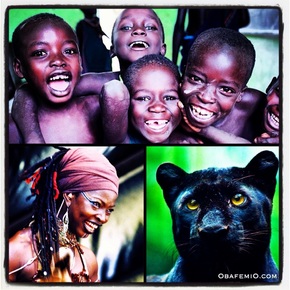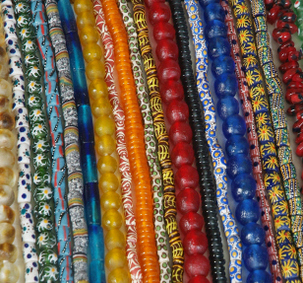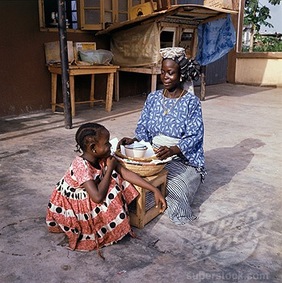The Agbole: Sanctuary of Orisa Lifestyle

Traditionally, the Agbole is the bedrock of Orisa Lifestyle. Each Yoruba principality is divided into hierarchical units, under the jurisdiction of an appropriate chief. The Oba and palace chiefs serve as the overarching rulers. Directly under them is the Adugbo (quarter), headed by an Olori Adugbo or Olori Itun, whose appointment is ratified and approved by the Oba. Below this is the Agbole (extended family compound), headed by the Bale, (Father of the house). The most basic unit is the individual nuclear family, headed by Olori Ebi (head of the family). While the appointment of the Bale is technically determined by the extended family members, the oldest, most responsible male usually assumes this position. The approval of the Oba is never sought in the matter. Similarly, every married man serves as the leader in his own home. Because the family is the basic organizational pattern of the larger society, it is the building block of all administrative, economic, judicial and spiritual activities. In other words, legal and political control is exercised mainly via the family and extended kin groups. [i] Most importantly, the objective of the Agbole structure and administration is to promote consistency, healing and interdependence, all of which contribute to the Good Condition.
Commitment to Excellence
Each Agbole adheres to strict performance expectations. These expectations help the community attract and retain GREAT people, who value accountability and aspire to excellence in everything they do. One indispensable feature of the Agbole structure is the age and gender-specific groups, called egbe. These egbe provide the structure for age and gender specific instruction and activity. Ultimately, the most senior member of the Agbole hierarchy is the Bale, who in most cases, is also a babalawo. The Bale's pronouncements - ratified by Ifa - are final. In this way, he settles quarrels among members and maintains discipline. When there is a quarrel, he might settle it or defer to the Olori Ebi (head of household), depending on the nature and seriousness of the issue. The Olori Ebi is required to manage the affairs of his own kinsmen and sponsors. His “court” is an informal one that only deals with internal cases involving members of his extended family and constituency. He settles internal cases and sanctions the guilty, either by imposing a fine (oji), a service, or simply by making them give a verbal apology. The Bale recognizes the Olori Adugbo’s authority and supports all decisions that reinforce the mission and purpose of the Agbole.
Commitment to Excellence
Each Agbole adheres to strict performance expectations. These expectations help the community attract and retain GREAT people, who value accountability and aspire to excellence in everything they do. One indispensable feature of the Agbole structure is the age and gender-specific groups, called egbe. These egbe provide the structure for age and gender specific instruction and activity. Ultimately, the most senior member of the Agbole hierarchy is the Bale, who in most cases, is also a babalawo. The Bale's pronouncements - ratified by Ifa - are final. In this way, he settles quarrels among members and maintains discipline. When there is a quarrel, he might settle it or defer to the Olori Ebi (head of household), depending on the nature and seriousness of the issue. The Olori Ebi is required to manage the affairs of his own kinsmen and sponsors. His “court” is an informal one that only deals with internal cases involving members of his extended family and constituency. He settles internal cases and sanctions the guilty, either by imposing a fine (oji), a service, or simply by making them give a verbal apology. The Bale recognizes the Olori Adugbo’s authority and supports all decisions that reinforce the mission and purpose of the Agbole.
Agbole Foundation of America

Today, in addition to its political functions, the Agbole is also a hub of òrìsà-related cultural activities, such as handcrafts, music or religious instruction. In keeping with tradition, the Agbole Foundation of America (AFA/The Agbole) is dedicated to creating hubs of òrìsà lifestyle in every city in the United States of America. The objective is to promote òrìsà lifestyle agreements as a methodology for bringing about the Good Condition, personally and collectively. As such, members and friends of the Agbole can regularly practice the orisa lifestyle agreements. Numerous ceremonies, such as Esentaiye (child blessing) should also be performed at the Agbole. Especially during public holidays, the Agbole should also serve as a cultural arts school for children and youth between the ages 5 and 19. In this regard, the Agbole establishes and reinforces behavioral guidelines that the membership can use to hold one another accountable for bringing about the Good Condition. The agbole approach is based on the understanding that orisa lifestyle is a holistic experience that actively promotes physical, emotional and intellectual development. To ensure that orisa lifestyle does not produce one-sided individuals, emotionally underdeveloped or culturally misguided, the more sublime aspects of human nature must constantly be exercised, nourished, and channeled.
A Place to Call Home
The Agbole provides the very best context for people to feel more valued for who they are and what they do. The Agbole is a kind of ecosystem where people are actively involved in orisa lifestyle. Through the various aspects of participation in the Agbole, the individual discovers multiple opportunities to show up and serve in ways that are cherished within the local community. Here Yorùbá arts and practical skills become essential, educating not only the heart and the hand but, in very real ways, the mind as well. Unlike Western art forms, in which beauty is an end to itself, the Yorùbá artistic tradition considers the elements of beauty, such as symmetry, balance and precision to imply ìwà, essence.[1] Hence the proverb ìwàlewà, which means ‘essence is beauty.’ The Agbole model demonstrates, beyond the shadow of a doubt, the unique ways in which Yorùbá indigenous knowledge systems can prepare communities of interest to positively change the world and not be victimized by it.
That orisa lifestyle has withstood the horrors of the Middle Passage, slavery and colonization, and has firmly established itself within the national cultures of Cuba, Brazil, Haiti and the United States, reflects the triumph, the relevance, as well as the permanence of Yorùbá indigenous knowledge systems. “The Yorùbá remain the Yorùbá precisely because their culture provides them with ample philosophic means for comprehending, and ultimately transcending the powers that periodically threaten to dissolve them.”[2] Therefore, our concern, as men and women of consequence, is to harness within ourselves that expression of orisa lifestyle that directly addresses the imperatives of reality, while at the same time remains aligned with principles of sustainable culture.
Here, we see that the Agbole model is so well suited to cultivate sustainable culture because orisa lifestyle is, by definition, holistic. That is, the organizing principles of orisa lifestyle are characterized by their philosophical, cultural and ecological interdependence. According to philosopher Adébáyò Adésànyà, “this is not simply a coherence of fact and faith, not of reason and traditional beliefs, nor of reason and contingent facts, but a coherence of compatibility among all the disciplines. A medical theory e.g., which contradicted a theological conclusion was rejected as absurd and vice versa. This demand of mutual compatibility among all the disciplines…was the main weapon of Yorùbá thinking. God might be banished from Greek thought without any harm being done to the logical architecture of it, but this cannot be done in the case of the Yorùbá… Philosophy, theology, politics, social theory, land law, medicine, psychology, birth and burial all find themselves logically concatenated in a system so tight that to subtract one item from the whole is to paralyze the structure of the whole.”[3] Orisa lifestyle is a system that enables many levels of consistency.
To further illustrate the sustainable qualities of the Agbole model, let us consider òwò, the craftsmanship system that is integral to all aspects of orisa lifestyle.
A Place to Call Home
The Agbole provides the very best context for people to feel more valued for who they are and what they do. The Agbole is a kind of ecosystem where people are actively involved in orisa lifestyle. Through the various aspects of participation in the Agbole, the individual discovers multiple opportunities to show up and serve in ways that are cherished within the local community. Here Yorùbá arts and practical skills become essential, educating not only the heart and the hand but, in very real ways, the mind as well. Unlike Western art forms, in which beauty is an end to itself, the Yorùbá artistic tradition considers the elements of beauty, such as symmetry, balance and precision to imply ìwà, essence.[1] Hence the proverb ìwàlewà, which means ‘essence is beauty.’ The Agbole model demonstrates, beyond the shadow of a doubt, the unique ways in which Yorùbá indigenous knowledge systems can prepare communities of interest to positively change the world and not be victimized by it.
That orisa lifestyle has withstood the horrors of the Middle Passage, slavery and colonization, and has firmly established itself within the national cultures of Cuba, Brazil, Haiti and the United States, reflects the triumph, the relevance, as well as the permanence of Yorùbá indigenous knowledge systems. “The Yorùbá remain the Yorùbá precisely because their culture provides them with ample philosophic means for comprehending, and ultimately transcending the powers that periodically threaten to dissolve them.”[2] Therefore, our concern, as men and women of consequence, is to harness within ourselves that expression of orisa lifestyle that directly addresses the imperatives of reality, while at the same time remains aligned with principles of sustainable culture.
Here, we see that the Agbole model is so well suited to cultivate sustainable culture because orisa lifestyle is, by definition, holistic. That is, the organizing principles of orisa lifestyle are characterized by their philosophical, cultural and ecological interdependence. According to philosopher Adébáyò Adésànyà, “this is not simply a coherence of fact and faith, not of reason and traditional beliefs, nor of reason and contingent facts, but a coherence of compatibility among all the disciplines. A medical theory e.g., which contradicted a theological conclusion was rejected as absurd and vice versa. This demand of mutual compatibility among all the disciplines…was the main weapon of Yorùbá thinking. God might be banished from Greek thought without any harm being done to the logical architecture of it, but this cannot be done in the case of the Yorùbá… Philosophy, theology, politics, social theory, land law, medicine, psychology, birth and burial all find themselves logically concatenated in a system so tight that to subtract one item from the whole is to paralyze the structure of the whole.”[3] Orisa lifestyle is a system that enables many levels of consistency.
To further illustrate the sustainable qualities of the Agbole model, let us consider òwò, the craftsmanship system that is integral to all aspects of orisa lifestyle.
Orisa Economics in Action

Òwò refers to handcrafts, like carving, weaving or pottery. As an institution, it offers priceless insights into the philosophical, cultural and historical interdependence of orisa lifestyle. Bead making, for example, is said to have been created by òrìshà Olókún, the wealthiest trader, the owner of the deep seas and the wife of Odúdúwa. Furthermore, according to Oladosu Agboleri, who is a member of Ilè Ifè’s most active bead making family, bead makers are actual descendants of Olókún. “Beads in ancient Ifè and among the Yorùbás in general, meant wealth. If somebody became very rich, the question the Yorùbá people would ask themselves is ‘tabi o jin sinu akun?’ (Did he find a treasure of beads?) Bead makers in Ilè Ifè after Olókún believed that all beads found inside the ground belonged to Olókún. They also believed that they must invite the spirit of Olókún before making beads…”[4]
Similarly, the art of weaving is said to have been created by òrìshà Obalufon, an 11th century Yorùbá king. Thus, weavers placate Obalufon for blessings when making cloths. Worshiping is carried out in front of their looms, which serve as shrines. Additionally, the symbols and motifs commonly associated with kìjipá cloth, for example, further reinforce the philosophical, cultural and historical interdependence of orisa lifestyle. Obalufon is not represented physically on kìjipá cloths. Instead, symbolic motifs like that of omoólé the wall gecko, and irè, the cricket are used as symbols. Using these symbols on kìjipá is one of the main avenues through which the deity can be pleased and the worshipers and users of kìjipá cloths receive their blessings and favor. The kìjipá cloth with the gecko motif is prescribed by Babaláwo and Olórìshà for childless women and those who give birth to àbikú because it is believed that the child will mimic the behavior of the gecko i.e., omoólé kìí kúrò ní ilé rè (the wall gecko does not leave his home). Likewise, kìjipá cloth with the ehin irè (cricket teeth) motif is prescribed for women praying for healthy babies, who, upon birth will cry out as strongly and vibrantly as the cricket’s chirping. Also, people who cover themselves in kìjipá cloth are said to be indirectly protected from illness, evil and misfortune. Egúngún masquerades use kìjipá cloth for their costumes (èkú eégún).[5]
In this sense, we can see how the òwò system acts as a medium through which symbolism, proverbial wisdom, traditional medicine and the physical environment are integrated into craft production in such a way that an otherwise mundane practice like weaving becomes transformed into a deeply meaningful exercise. Thus, the òwò system reinforces philosophical, cultural and historical interdependence in orisa lifestyle. Not only that, when you consider the conditions in which people traditionally make use of beads or fabric, it's easy to understand the emotional intensity associated with those symbols.
Social Structure
In addition to their associations with specific orisa, each of the òwò disciplines is associated with a particular agbole, or family compound, as well (e.g., the Agboleri bead makers of Ifé). Within each agbole, fathers and mothers practice gender specific versions of their trade, and pass on “trade secrets” to their sons and daughters, respectively. In the case of the weavers, for example, ” P.S.O. Aremu writes, “the men keep strictly to the horizontal or belt loom to produce strips of 4 ½” wide, while their women counterparts can produce on their own vertical looms wider kìjipá strips of about 21”… The children learn to weave in the traditional way, from infancy, so that before they attain the age of ten, various aspects of weaving could have been mastered. The trainees are expected to have oye, intelligence; ojú inú, insight; ojú oná, an eye for creativity; ìlutí, the inner ear/openness to instruction.”[6]
In the pre-colonial era, the members of each agbole belonged to an egbé. In the case of the weavers it was the egbé alásho ìbíbé of a particular kingdom, town or village. In any case however, the egbé was responsible for controlling standards, quality and pricing, among other things. Invariably, each egbé would have its own Modewa chief in the Oba’s palace, which assured the craftsmen and their deities adequate access to and protection by the Oba, as well as the local chiefs, who were their greatest patrons.[1] The social structure described here represents the parameters within which the philosophical, cultural and historical interdependence of orisa lifestyle has taken place for thousands of years. Most significantly, perhaps, it demonstrates how the agbole represents the fundamental educational, political, economic, legal, as well as spiritual unit of orisa lifestyle.
Similarly, the art of weaving is said to have been created by òrìshà Obalufon, an 11th century Yorùbá king. Thus, weavers placate Obalufon for blessings when making cloths. Worshiping is carried out in front of their looms, which serve as shrines. Additionally, the symbols and motifs commonly associated with kìjipá cloth, for example, further reinforce the philosophical, cultural and historical interdependence of orisa lifestyle. Obalufon is not represented physically on kìjipá cloths. Instead, symbolic motifs like that of omoólé the wall gecko, and irè, the cricket are used as symbols. Using these symbols on kìjipá is one of the main avenues through which the deity can be pleased and the worshipers and users of kìjipá cloths receive their blessings and favor. The kìjipá cloth with the gecko motif is prescribed by Babaláwo and Olórìshà for childless women and those who give birth to àbikú because it is believed that the child will mimic the behavior of the gecko i.e., omoólé kìí kúrò ní ilé rè (the wall gecko does not leave his home). Likewise, kìjipá cloth with the ehin irè (cricket teeth) motif is prescribed for women praying for healthy babies, who, upon birth will cry out as strongly and vibrantly as the cricket’s chirping. Also, people who cover themselves in kìjipá cloth are said to be indirectly protected from illness, evil and misfortune. Egúngún masquerades use kìjipá cloth for their costumes (èkú eégún).[5]
In this sense, we can see how the òwò system acts as a medium through which symbolism, proverbial wisdom, traditional medicine and the physical environment are integrated into craft production in such a way that an otherwise mundane practice like weaving becomes transformed into a deeply meaningful exercise. Thus, the òwò system reinforces philosophical, cultural and historical interdependence in orisa lifestyle. Not only that, when you consider the conditions in which people traditionally make use of beads or fabric, it's easy to understand the emotional intensity associated with those symbols.
Social Structure
In addition to their associations with specific orisa, each of the òwò disciplines is associated with a particular agbole, or family compound, as well (e.g., the Agboleri bead makers of Ifé). Within each agbole, fathers and mothers practice gender specific versions of their trade, and pass on “trade secrets” to their sons and daughters, respectively. In the case of the weavers, for example, ” P.S.O. Aremu writes, “the men keep strictly to the horizontal or belt loom to produce strips of 4 ½” wide, while their women counterparts can produce on their own vertical looms wider kìjipá strips of about 21”… The children learn to weave in the traditional way, from infancy, so that before they attain the age of ten, various aspects of weaving could have been mastered. The trainees are expected to have oye, intelligence; ojú inú, insight; ojú oná, an eye for creativity; ìlutí, the inner ear/openness to instruction.”[6]
In the pre-colonial era, the members of each agbole belonged to an egbé. In the case of the weavers it was the egbé alásho ìbíbé of a particular kingdom, town or village. In any case however, the egbé was responsible for controlling standards, quality and pricing, among other things. Invariably, each egbé would have its own Modewa chief in the Oba’s palace, which assured the craftsmen and their deities adequate access to and protection by the Oba, as well as the local chiefs, who were their greatest patrons.[1] The social structure described here represents the parameters within which the philosophical, cultural and historical interdependence of orisa lifestyle has taken place for thousands of years. Most significantly, perhaps, it demonstrates how the agbole represents the fundamental educational, political, economic, legal, as well as spiritual unit of orisa lifestyle.
The Agbole Method

In the simplest language, however, the Agbole is, and will always be, the extended family dwelling, where the young and old work and play together. Here, family songs and vocational traditions are passed from generation to generation. Agbole is the place where adults join together to build a common bond in favor or teaching orisa lifestyle to the children. That is, the child who has learned to make an ancestral mask, or pounded yam has gained self-discipline and practical skills. Our approach represents the appropriate balance between "what" to practice and "how" to practice it. Balanced methodology is particularly important in the earliest stages of devotion, when the foundation for all further intellectual and social development is laid. However, whereas most contemporary temples tend to over-emphasize spiritual materialism, the Agbole methodology takes place in such a way that development continually affirms individual purpose in relationship to the greater community, taking into account her age, culture and maturity. For example, in the earliest stages of orisa devotion, when the learning curve is very steep, it is typical for people to clamor for the "data dump" of massive amounts of songs, chants and elaborate rituals. The Agbole approach is quite different. Instead of bombarding the devotee with abstract trivia, or over exposing him to sacramental rituals, we create a rich, familiar environment in which the individual can impose her creative will onto real life problems. Then, when the individual is introduced to any kind of specialized information, ritual or dream experience, it happens within the context of how she is responding to the real needs of her day-to-day life. Within this context, it is easier for each member of the Agbole to play a significant part in socializing younger members and motivating them to uphold certain standards of excellence.
[1] Adediran, Biodun. Government and Administration of Ifé in Pre Colonial Times. 1980
[1] Thompson. op cit
[2] Thompson, Robert Farris. Flash of the Spirit. 1984
[3] Adesanya, Adebayo. Yorùbá Metaphysical Thinking. Odú 5, Ibadan 1958.
[4] Adeduntan, J. Early Glass Bead Technology of Ilè Ifé. West African Journal of Archeology. 1985
[5] Aremu, P.S.O. Yorùbá Traditional Weaving: Kìjipá Motifs, Color and Symbols. Nigeria Magazine, 1982.
[6] Aremu, op cit production, distribution and marketing throughout Yorùbáland.
[i] ONADEKO, Tunde. YORUBA TRADITIONAL ADJUDICATORY SYSTEMS. Page 6-7.
[1] Adediran, Biodun. Government and Administration of Ifé in Pre Colonial Times. 1980
[1] Thompson. op cit
[2] Thompson, Robert Farris. Flash of the Spirit. 1984
[3] Adesanya, Adebayo. Yorùbá Metaphysical Thinking. Odú 5, Ibadan 1958.
[4] Adeduntan, J. Early Glass Bead Technology of Ilè Ifé. West African Journal of Archeology. 1985
[5] Aremu, P.S.O. Yorùbá Traditional Weaving: Kìjipá Motifs, Color and Symbols. Nigeria Magazine, 1982.
[6] Aremu, op cit production, distribution and marketing throughout Yorùbáland.
[i] ONADEKO, Tunde. YORUBA TRADITIONAL ADJUDICATORY SYSTEMS. Page 6-7.